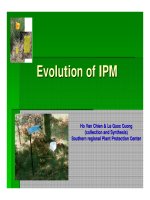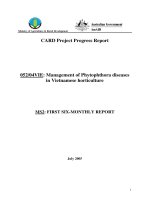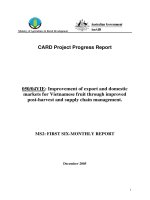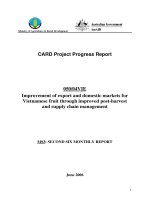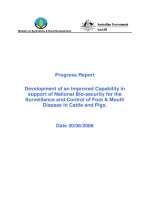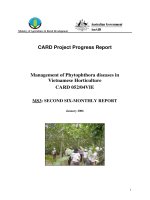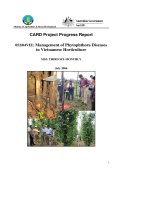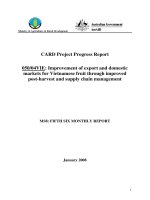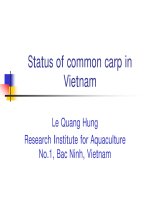Báo cáo nghiên cứu khoa học " ESTABLISHMENT OF THE GLOBALGAP SYSTEM FOR DRAGON FRUIT FAMERS AND EXPORTER IN THE SOUTHERN PROVINCES " pptx
Bạn đang xem bản rút gọn của tài liệu. Xem và tải ngay bản đầy đủ của tài liệu tại đây (1.43 MB, 6 trang )
Collaboration for Agriculture and Rural Development
(CARD)
Program
38
ESTABLISHMENT OF THE GLOBALGAP SYSTEM FOR DRAGON FRUIT
FAMERS AND EXPORTER IN THE SOUTHERN PROVINCES
Proj
ect title:
Developing GAP systems for dragon fruit producers and exporters in Binh Thuan
and Tien Giang provinces
Project c
ode
:
CARD
037/04 VIE
Authors:
Nguyen Van Hoa
1
,
Nguyen Huu Hoang
1
,
John M. Campbell
2
, Nguyen Minh Chau
2
Project Implementing organi
sations:
1
Southern Fruit Research Institute
2
Horticulture and Food Research Institute of New Zealand
SUMMARY
In Vietnam, at present, the area for dragon fruit is over 13,500 ha with the production of more than
211,000 tones and the average area per ho
usehold is 0.5
-
1 ha. Returns from dragon fruit (DF) could
be significantly improved if small growers and exporters can gain access to new high value markets in
Europe and North America. We have established a private sector working pilot of exporter, pack
er
and supplying DF growers in which the European high value market driven standards of BRC at the
packer and GlobalGAP at the farmer level have been implemented. And the results coming with (i)
Field farmers’ benchmarking survey were completed and its rep
ort was delivered to SOFRI personnel,
packers, farmers, MARD and DARD personnel in 2007. (ii) Selection of a packer/exporter and farmer
group for the GlobalGAP implementation. Training of the Pilot members for improvement towards
British Retailers Consorti
um: Global Standard
–
Food (BRC) for the packer and
EurepGAP/GlobalGAP for the farmers were carried out to enable them to reach compliance in all
areas. The pilots both for field production and packhouse were implemented and all the corrections
have been d
one and then the Certification for EURAPGAP with 80 ha of dragon fruit production has
been achieved in 2007 and re
-
certified and expanded for GlobalGAP in 2008 with 230 ha and again
in 2009 with the same areas, while the packhouse are being auditing for BR
C certification. (iii) The
dragon fruit quality manuals for the farmer and packer were developed by John Campbell to enable
the farmer and packer to meet compliance with the EUREPGAP and BRC standards in 2006.
Translation of the Manual into Vietnamese has
been distributed to the farmers and packers. The
Vietnamese personnel have upgraded the EUREGAP manual to GlobalGAP in Vietnamese and the
BRC also revised to the new version 5 in Vietnamese. (iv) The national personnel capacity building in
GlobalGAP and BR
C were well done with plenty of technical staff and farmers trained.
1.
Introduction
Recently, dragon fruit production in Vietnam
was about more than 13,500 ha producing with
approximately 211,000 tons with the average
farm’s holder from 0.5 to 1.0 ha d
epending on
production areas of which are either in
Mekong Delta Regions or in Binh Thuan
province (Nguyen Minh Chau, 2007). The
benefits from dragon fruit industry will be
improved significantly as if small land
-
holding
dragon fruit farmers and exporters
could
expand its markets to the new and high value
ones in EU or Northern America. This,
however, the dragon fruit exporters should be
market driven and initiative in exploring
potential markets for themselves. He high
value markets from Japan, EU and Nort
hern
America etc. required for quality dragon fruits
but refused Vietnam’s dragon fruits due to
under quality and unsafe fruits. The project of
Developing of quality systems of GlobalGAP
for dragon fruit producers and exporters in the
South of Vietnam, was
aimed to develop a
CARD 037/04VIE
–
Developing GAP system for dragon fruit
39
system for dragon fruit industry in ensuring of
quality for exporting to high value markets.
Establishment of pilot model for dragon fruit
packing house
–
export and contracted
supplying producers targeted to export markets
in EU which
required for BRC and
EurepGAP/GlobalGAP standards.
2.
Materials
and methods
Project life
-
span was from 2005 to 2010, and
laid out in dragon fruit production areas in
Binh Thuan, Tien Giang and Long provinces.
The common aim was “Benefit of each
stakehold
ers participating in this project of
implementation of GAP from high value
markets was always higher than as compared
to before implementing GAP”. Higher revenue
from producing, packaging and exporting of
dragon fruit compliance to GAP will ensure
the sust
ainable growth in dragon fruit industry.
This growth also ensures the increase of
mummer of small land holders to join in the
programme and therefore the improvement of
rural life standards is indispensable.
The enhancement of national capacity both in
pub
lic and private sectors through practical
implementing of GAP is included.
Evaluation of practical producing of dragon
fruit in Vietnam in comparison to
EUREPGAP standards by surveillance in a
large scale from Binh Thuan to Tien Giang
and Long provinces, t
he development of
questionnaire and result analysis and
evaluation were carried out by
HortResearch’s experts.
Enhancement in knowledge of dragon fruit
producing for SOFRI’s staff and
establishment of systems to improve the
sustainable production and reso
lve the
problems and issues in practical production.
Development of pilot farm model
compliance EurepGAP/GlobalGAP
standards for group of farmers and a pilot
packing house certified for BRC for
exporter/packer. To establish the quality
systems which meet t
he requirements,
SOFRI’s staff had organized a number of
training courses and consultancies as well
for farmers and packers.
Development of dragon fruit GlobalGAP
quality manual, Vietnam counterpart had to
develop the codes and suitable training
materials,
safety for environment for
friendly implementation and feasible for
dragon fruit pilot model as well as for other
cases or crops.
Establishment of required quality systems for
dragon fruit industry to implement and also
regard as core of solid system in e
nabling the
pilot model got certified for
EurepGAP/GlobalGAP standards.
3.
Research results and discussions
3.1
Benchmarking survey of dragon fruit
production
The benchmarking survey of dragon fruit
production was conducted by end of July 2005.
There were
125 farmers in Binh Thuan and 30
farmers in Long An and Tien Giang provinces
to be interviewed to collect data. SOFRI’s
project staff had interviewed and collected data
using the questionnaire and also recorded the
information on cultivation practices and
other
related techniques which were relevant to
practical producing of dragon fruit.
The survey data were analysed at
HortResearch by Dr. Jim Walker and Patrick
Connolly had prepared the report by Power
point for John Campbell presented at SOFRI
during th
e trip visit and working at Vietnam in
March and April 2007. The presentation was
then, used as tools in training for farmers and
packers in this area.
3.2
Development of quality manual
The manual was first written by English and
the translated into Vietna
mese. The manual
development was based up the specific
background which met to the requirements of
quality systems for the project pilot model, for
the farmer section complying to EUREPGAP
and section for packer was based on BRC
(British Retailers Consorti
um, Global
Standard: Food) and this is a live document
(can be added on or corrected) to update
whenever the standard or condition changed.
Nguyen Van Hoa, Nguyen Huu Hoang, John M. Campbell & Ngu
yen Minh Chau
40
By the end of 2007 and in early 2008, SOFRI’s
project personnel had re
-
written the manual as
a version 2.0: upgrad
ing the EurepGAP to
GlobalGAP standards with changes in content
and form; Re
-
writing and upgrading the
quality management system for packing house
to become a manual for Dragon fruit quality
management system manual
–
for packer
compliance to BRC standards
–
Issue 5.
3.3
Establishment of programme for
implementation GAP pilot models
3.3.1
Choose for standards of quality
management systems
At farm level, EUREPGAP standard and at
packing house, BRC standard were selected for
implementation. The b
oth standards will be
supplementing to each other to ensure dragon
fruit being produced and packed in a quality,
legality and meeting the requirements of high
value markets, “satisfaction of customers’
demands” on traceability.
3.3.2
At packer level
Hoang
Hau Company’s dragon fruit packing
house was selected as packaging pilot model.
Thereafter, project team had negotiated with
Mr. Tran Ngoc Hiep (director) about level of
implementation and the collaboration with
project in development of the packing house
to
comply with BRC standard. By mid 2006, an
MOU between Mr. Tran Ngoc Hiep and Dr.
Nguyen Minh Chau was signed.
In February 2007, Mr. Hiep had operated the
plan of expanding his packing house to larger
scale in future. The quality manual had
transferred
to Mr. Hiep both Vietnamese and
English versions.
While, in the meantime, SOFRI’s project team
had conducted a number of
trainings/consultant for positions working in
the packing house and farm owners/managers.
The contents of trainings and consultants ar
e
including: customers and customers’ demands;
quality systems, objectives, packing house
management, establishments and management;
identification of “progress”; from farm through
packing house to exporters; the linking
between farmers and packer, respons
ibilities
and expectations; Dragon fruit quality manual,
writing, scope and implementation;
identification of weakness, instructions for
improvements with the purpose of
improvement of the packing house, farms in
according to the requirements of project pi
lot
model, meeting to the quality manual and
needed standards; Specification of position in
the process and assumption the responsibility
as the position description stated in the in the
quality manual; training for each position
stated as its responsibili
ty in the pilot; Roles of
internal auditor; responsibility of internal
auditor; process of improvement and
promotion for sustainable production.
Dragon fruit
Quality
Manual fo
r
P
roducers and Packing house
and GAP Manual for
fruit
producers
CARD 037/04VIE
–
Developing GAP system for dragon fruit
41
3.3.3
At farm level
The farmer group was set up and trainings
were conducted for farmers on quality systems
whi
ch fetch back more benefits if compliance
to GAP. The project had also focused and
instructed farmers specifically to help them to
approach and comply with the standards before
the auditing of certify body. The selected
farmers’ group, however, could not m
eet the
requirements due to lack of investment and too
much depend on middlemen
–
collectors and
these issues were not expected by project. The
project, therefore, came back with selected the
contracted farmers’ group supplying for
packing house of Hoang H
au Dragon Fruit
company and then to process the project as
above said.
Implementation of GAP on farm by
project experts with farmers
Internal auditing and correction farmer
’s
records
3.4
Certification and expanding the GAP
dragon fruit pilot model
Project team had negotiated with SGS Vietnam
(Société Générale de Surveillance),
responsibility for Vietnam, Indonesia and New
Zealand, an international certify body, to
provid
e information on auditing, evaluation the
potential of certifying of project. General
information on progress of implementation of
the pilot model based on internal audit
checklist of BRC/EUREPGAP to evaluate the
model, certification and lastly, 80 ha of d
ragon
fruit was certified for EUREPGAP in 2007.
Base on the certified project pilot model
–
Hoang Hau Dragon Fruit company and its
contracted supplying farmers’ group, got re
-
certificated by October 2008, with increase in
area up to 230 ha (compared to 80
ha in 2007)
and it was repeated in 2009. The achievement
came from the enhancement of capability of
local facilitators of project in regarding of
techniques and proper skills in organisation
and implementation.
Currently, the project team is working to
exp
and the GlobalGAP dragon fruit model in
Tien Giang province up to 100 ha by the end
of 2009 or 2010; While, in Long An province,
the GlobalGAP dragon fruit model of 30 ha is
being developed with expectation for
certification by the end of 2010, and plan to
expand up to 400
–
500 ha.
GlobalGAP certification for contracted farmer
group supplying dragon fruit to Hoang Hau
Dragon Fruit Co.
Xuan Vinh dragon fruit farm’s map, Ham Thuan
Nam
–
Binh Thuan province
Collaboration for Agriculture and Rural Development
(CARD)
Program
42
Though, SOFRI’s project team had made all
effo
rt in delivering the project but till now the
BRC certification could not be completed due
to the reasons below:
The pilot packer did not spend all effort and
investment for the packing house in
compliance to the selected standard; this is
of the significa
nt decline in fruit price in
recent years.
There was a significant change in packing
house staff, trained staff for HACCP, BRC,
GlobalGAP, Internal Audit etc. left the
position, and then project team had to
delivered same trainings for other staff, but
sti
ll lack of packing house personnel.
Asian markets’ varying, especially China
market had made a considerable effect to
the production of dragon fruit pilot model.
BRC issue 5 was more difficult to the
packer than the issue 3.
There were some problems and co
nstraints
arising between X
-
ray plant owner with
packer/exporter.
3.5
Building capacity
While delivering the project, Mr. Nguyen Huu
Hoang had visited fruit GlobalGAP farms and
BRC packing houses etc. in New Zealand and
also participated in 2
-
day training
course for
Internal Auditing at Hasting NZ in July 2006.
After that, through the agreement from New
Zealand Organization of Quality (NZOQ), a
training course for Introduction to Internal
Auditor had been delivered to 8 staff of SOFRI
by John Campbell and
Nguyen Huu Hoang,
using parts of training materials of the same
course provided by NZOQ.
As above said, Vietnam project team had also
practically trained and learnt through project
delivering to the pilot, documented materials
and experience from project
expert. SOFRI’s
project team, therefore, had up
-
graded
successfully the dragon fruit quality manual
version 2.0 and even for other crops such as
mango and citrus crop.
SOFRI’s staff and other facilitators from
established model of GlobalGAP of 30 people
ha
d also trained by SGS
–
Vietnam for
GlobalGAP, HACCP, Internal Audit and
Inspection in 2008.
Dr. Nguyen Minh Chau, Dr. Nguyen Van Hoa
and Mr. Vo Huu Thoai had played role in
developing the general regulations of VietGAP
standard, this standard was issued o
n 28th
December 2008.
Dr. Nguyen Van Hoa, had established and
consulted for mango GlobalGAP model at
Song Hau Farm, as part of national project in
which Dr. Nguyen Minh Chau was a project
leader, and 11.7 ha mango farm had been
certified for GlobalGAP in 2
008.
In 2009, SGS
–
Vietnam had organized a
training course for Lead Auditor (LAC) in
which two SOFRI’s staff, Dr. Nguyen Van
Hoa and Nguyen Huu Hoang were invited and
qualified to be the lead auditor.
SGS
–
Vietnam training on HACCP and
Internal Audit for SOFRI and provincial staff
Trainings on GAP, IPM on dragon
fruit for farmers
Nguyen Van Tuat, Pham Ngoc Dung, Nguyen Thi Ly, Le Thu Hien
43
3.6
Publication
During delivering project, a number of
publications had been released,
in which some
major publishing listed below:
Handbook for GAP fruit production.
Agricultural Publisher, 2007.
Handbook for trainer for GAP fruit and
vegetables (Training guidelines for trainer
who are playing role as extension workers,
technicians, member
s of Farming
Association and etc.). Agricultural
Publisher, 2008.
Dr. Nguyen Van Hoa also joined in another
CARD project
–
IPM for citrus crop, he
also developed the citrus GlobalGAP
quality manual both in English and
Vietnamese languages.
Dr. Nguyen Van
Hoa and Mr. Nguyen
Thanh Hieu had participated a seminar on
Dragon fruit production, markets and
exportation: challenges and potentials, held
at Putrajaya, Malaysia on 20th November
2008. Dr. Hoa had reported with a power
point presentation on: Status of
research
activities and the development of GAP
system in Vietnam.
4.
Conclusions and recommendation
s
From the archived results, we could have some
following conclusions:
The benchmarking survey on dragon fruit
production and from the analytical data and
d
iscussions, some weakness had been found
and needed to pay more attentions for
correction and improvement to approach to
and to get certificated for GlobalGAP for
230 ha of dragon fruit in 2008 and renewed
certification the same area in 2009.
Two quality
manual had been developed by
project: (i) EurepGAP dragon fruit quality
manual, after that, SOFRI’s project team
had upgraded the EUREPGAP manual to
GLOBALGAP with some details was put in
and increase in content volume for producer
and packer. (ii) Separat
ion of section for
BRC
–
standard for packing house and
packer with other sections and also
upgraded from issue 3 to issue 5.
Organising a number of training courses on
GlobalGAP, ICM, safe use of agri
-
chemical, first aid, safe growth, etc. with
certificat
ion granting to the trainees to
prove to auditor during certification
auditing.
Publishing three handbooks on GAP,
VietGAP and other documents and
materials, participation into several
workshops/seminars with presentation
topics on sharing experiences on
i
mplementation of GAP.
Training for SOFRI or provincial staff on
Internal audit and inspection, HACCP, in
which two SOFRI’s staff were recognised
as Lead auditors.
REFERENCE
1.
Nguyen Minh Chau, 2007. Present
SCENARIO, Market trends of the
tropical and subtr
opical fruit industry
in Vietnam, TFNet Report, 2007.
2.
GLOBALGAP
–
www.globalgap.org
